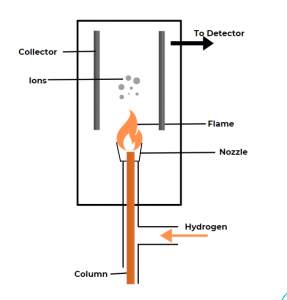GC-FID | Gas Chromatography Flame Ionization Detector
The Flame Ionization Detector (FID) stands out as the predominant detection method in Gas Chromatography (GC) for identifying and measuring organic compounds. The operational principle of the FID is relatively straightforward, and a drawing of this detector could be easily visualized in Figure 1. Initially, the sample is introduced into the GC, where it undergoes separation into its distinct components while traversing the column. Subsequently, these separated components exit the column and enter the combustion chamber of the FID. Within this chamber, the sample is combined with a hydrogen fuel-rich gas, typically H₂, and an oxidant that supports combustion, usually air. Consequently, the amalgam of the sample, H₂, and air is ignited, generating a flame.

Figure 1. Scheme of the FID
The hydrogen fuel present in the sample undergoes combustion, resulting in the production of ions and electrons. The high-energy electrons generated within the flame then ionize the analytes. Positioned above the flame, the FID features a collector electrode. The ions and electrons generated during the combustion process are attracted to the collector electrode due to an applied electric current. Upon reaching the collector electrode, they produce a current proportional to the carbon number.
The generated current is subsequently amplified and recorded by a detector. Following this, the detector signal undergoes processing, generating a chromatogram that displays peaks corresponding to the separated components in the sample. The height or area of these peaks is directly proportional to the concentration of the respective compounds in the original sample. Calibration curves are employed to establish the relationship between the detector response and the concentration of specific analytes.
FIDs exhibit sensitivity and possess a wide dynamic range, rendering them well-suited for the detection of a diverse array of organic compounds. Widely employed in environmental analysis, the petrochemical industry, and other fields requiring precise identification and quantification of organic compounds, FIDs play a crucial role in analytical chemistry.
Consumables and Spares
Spares:
- Insulator (2100003200)
- Tower seals, 25/pk (1500334701)
- Flame Tip Assy 0.02 ID (200193800)
- Flame Tip Assy 0.01 ID (200187500)
- Flame Tip Ferrule (2869462201)
- High Temp Flame Tip Ferrule (up to 450°C) (41312144)
Consumables:
| 41312148 | 15% GRAPHITE/85% VESPEL FERRULE 1/16″ WITH 0.4MM HOLE PK/10 |
| 41312149 | 15% GRAPHITE/85% VESPEL FERRULE 1/16″ WITH 0.5MM HOLE PK/10 |
| 41312150 | 15% GRAPHITE/85% VESPEL FERRULE 1/16″ WITH 0.8MM HOLE PK/10 |
| 41312153 | 15% GRAPHITE/85% VESPEL FERRULE 1/16″ NO HOLE PK/10 |
Order Today
For more information or to place an order, please get in touch.
